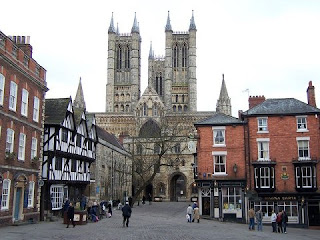Besides the fort and the settlement of veterans the Romans built something else that helped insure the town's future. The River Witham is marshy little thing passable only to small boats, so the Romans dug a canal 11 miles long connecting Brayford Pool to the larger River Trent. This canal, known as Foss Dyke, is still in operation, making it the oldest in Britain. It joined Lincoln to the sea and made possible its later rise as a trading center. Lincoln was also the meeting place of five major Roman roads, including the vital Ermine Street that connected London to York.
After the Roman withdrawal, York seems to have been essentially abandoned for centuries. Which is puzzling; other major Roman centers like York, Chester, London and Carlisle endured as inhabited places through the dark centuries, but so far as archaeologists can tell, Lincoln did not. It reemerged after the Danish settlement in the ninth century, one of the five most important towns of the Danelaw. The Domesday Book calls the place Lincolia and rates it the third largest town in England.
After the Conquest William the Bastard built one of his first castles there, and Lincoln Castle endured from then down to modern times.
The castle was fought over during several English civil wars. In 1141 King Stephen was captured there by the forces of Empress Mathilda, leading to the settlement that put of the Plantagenets on the English throne. The castle was attacked again in 1217 during one of the Barons' Wars; this is called the Second Battle of Lincoln, and it is depicted in the drawing above, by medieval chronicler Matthew Paris.In the twelfth century Lincoln joined in the great medieval economic boom. It was a center of trade and cloth manufacture; the Guild of Drapers (cloth merchants) was founded in 1130. They became particularly famous for a color called Lincoln Green, which of course later clothed Robin Hood and his Merry Men. Like good medieval townsmen anywhere in Europe, the people of Lincoln showed off their wealth by building a stupendous cathedral.Construction of the Cathedral began in 1072, and it was consecrated in 1124, but it was then destroyed by an earthquake in 1185 and rebuilt on a grander scale. Some sources say that from the completion of the central spire in 1311 down to the spire's collapse in 1548 it was the tallest building in the world.
I could go on posting cathedral pictures for a long time, but I have to move on, because it was not the cathedral that inspired me to write about Lincoln.
What I wanted to write about was, first, the amazing concentration of surviving medieval houses in the old town. Lincoln had the kind of history that makes for great preservation, booming down to the Black Death but then not recovering for centuries. So a lot of old buildings were repaired and updated over the centuries rather than being torn down and replaced with something grander. Like these houses on Steep Hill, said to date to the 12th century.And second, the remarkable number of these structures that relate to Lincoln's Jewish history. This is still known as Jew's House, now the Jew's House Restaurant. Lincoln had a sizable Jewish community around the time this house was built, circa 1150.This is now called the Norman House, but for centuries it was called Aaron the Jew's house. Aaron the Jew was such a famous international merchant around 1150, it seems, that stuff got named after him even though he had nothing to do with it.
The first significant Jewish colony in post-Roman Britain was invited in by William the Conqueror, since he had found Jews so useful in Normandy. English Jews had a variety of special royal protections, including the right to take shelter in any royal castle whenever a mob was trying to kill them. But their story was ultimately rather sad. Unofficial persecution intensified in the 12th century, in parallel with what looks like an increase in lay religious devotion. Lincoln was the scene of one of the worst incidents in 1155, when the disappearance of a boy named Hugh was blamed on the Jews, who were supposed to have taken him for blood sacrifices. There was a movement to make Hugh a saint, but the Pope never agreed. (Devotion to "Little Saint Hugh of Lincoln" popped up in England every so often from then down to the 1930s, and whenever you see it you know you're dealing with serious antisemites.) Really it was all downhill for Jews in England from then until 1290, when Edward I expelled all that remained in the kingdom and seized all their property.
But then everybody who lived in the 12th century is dead, persecuters and persecuted alike, and at least we have these wonderful buildings to help us remember them and their time.



















No comments:
Post a Comment